Clhmotjdxp ransomware (Free Guide) - Decryption Steps Included
Clhmotjdxp virus Removal Guide
What is Clhmotjdxp ransomware?
Clhmotjdxp ransomware is the cryptovirus that appends encrypted files using ransom character extensions
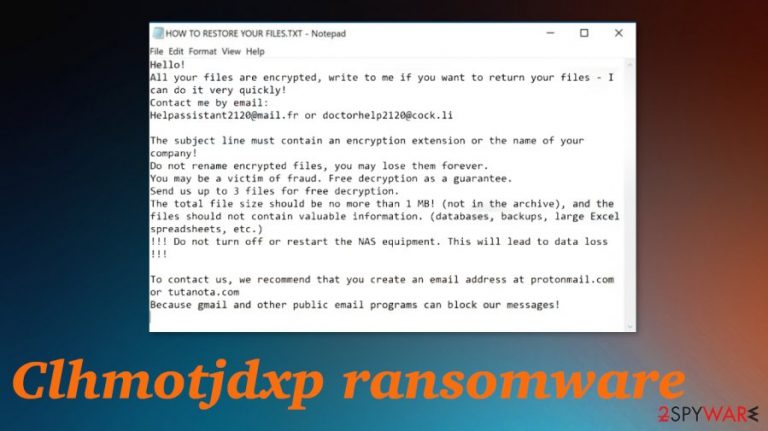
This Clhmotjdxp ransomware virus creates issues with the system when it manages to affect those common files on the system. Besides encryption procedures, infection can affect system functions and program performance, so the threat can become extremely persistent and dangerous.[2] This is the version of a known Snatch ransomware virus, so trusting the decryption offer is cont recommended, and you should remove the threat instead with reliable anti-malware software.
| Name | Clhmotjdxp ransomware |
|---|---|
| Family | Threat belongs to the family of Snatch ransomware |
| File extension | it uses a random character appendix, analyzed samples come with .clhmotjdxp at the end of the original filename |
| Ransom note | HOW TO RESTORE YOUR FILES.txt |
| Contact emails | helpassistant2120@mail.fr, doctorhelp2120@cock.li |
| Distribution | Files attached to the malicious emails can distribute the payload of the ransomware virus, so you can catch this cryptovirus by not paying attention to details on suspicious emails and while visiting shady/malicious pages |
| Elimination | You can remove Clhmotjdxp ransomware yourself, but the best option for such an infection would be anti-malware tools that dan detect[3] the intruder and associated application |
| Repair | Once the infection manages to get on the system, the virus can affect other functions and programs, so you should repair these altered or even corrupted programs and files. You can check the machine for any virus damage with FortectIntego and possibly fix those issues |
The ransom note for the .clhmotjdxp file virus states about the possible option for the victim and lists that the contact information is needed for them to write criminals with the alleged decryption tool. Unfortunately, even the supposed test decryption option shouldn't be considered as a viable method.
The ransom note file HOW TO RESTORE YOUR FILES.txt that gets added in various folders and on the desktop reads the following:
Hello!
All your files are encrypted, write to me if you want to return your files – I can do it very quickly!
Contact me by email:
Helpassistant2120@mail.fr or doctorhelp2120@cock.li
The subject line must contain an encryption extension or the name of your company!
Do not rename encrypted files, you may lose them forever.
You may be a victim of fraud. Free decryption as a guarantee.
Send us up to 3 files for free decryption.
The total file size should be no more than 1 MB! (not in the archive), and the files should not contain valuable information. (databases, backups, large Excel spreadsheets, etc.)
!!! Do not turn off or restart the NAS equipment. This will lead to data loss !!!
To contact us, we recommend that you create an email address at protonmail.com or tutanota.com
Because gmail and other public email programs can block our messages!
Clhmotjdxp ransomware creators might not bother to send you the decryption key or a tool that they allegedly have, so rely on system cleaning procedures and get rid of the infection before worrying about your affected files. There might be more options for the decryption in the future, so you can try to create a backup of the encrypted data and save that for the later use when a particular decryption tool gets released.
That takes a lot of time for malware researchers and experts, so if you want to use the machine again right now, you need to remove Clhmotjdxp ransomware completely using other methods. You should rely on trustworthy programs that are designed to fight malware and ensure proper security on the machine. SpyHunter 5Combo Cleaner or Malwarebytes can work for the procedure and help you with all the virus infections that can lure on the machine without your knowledge.
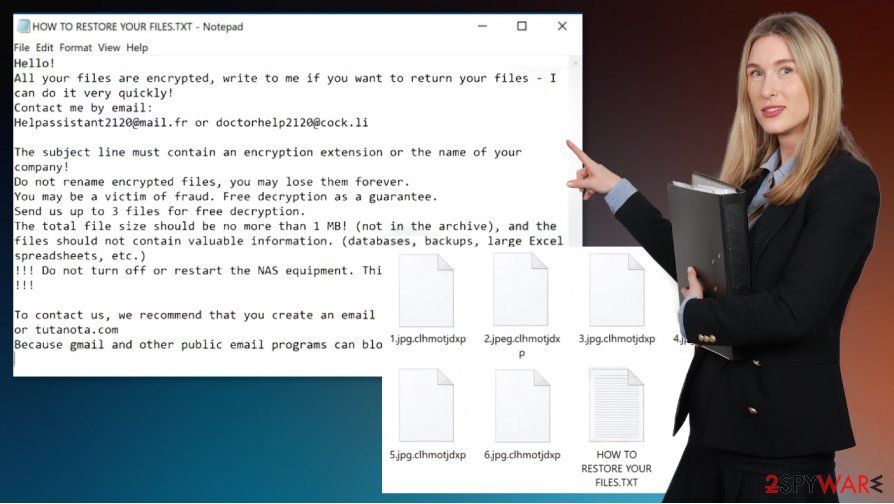
Find the best way for Clhmotjdxp file virus elimination
The correct way to approach this infection is to go for the proper Clhmotjdxp ransomware removal and then find ways to recover the affected data. An infection like this spreads using malicious scripts and other intruders' help because this is the best way to go for the targeted devices.
You cannot notice the ransomware installation, so before it sends the ransom note to your screen, you are clueless. This is why we recommend going for anti-malware tools when dealing with .clhmotjdxp virus and other ransomware-type infections.
Only then you can be sure that the system will get virus-free again. You shouldn't risk getting your data permanently deleted or damaged, so double-check before attempting to recover files after the infection removal. You can only load copies of the encoded files or rely on third-party software/ system features that can restore affected files for you. Do not forget about the possible damage Clhmotjdxp ransomware can cause, and try to repair that with apps like FortectIntego.
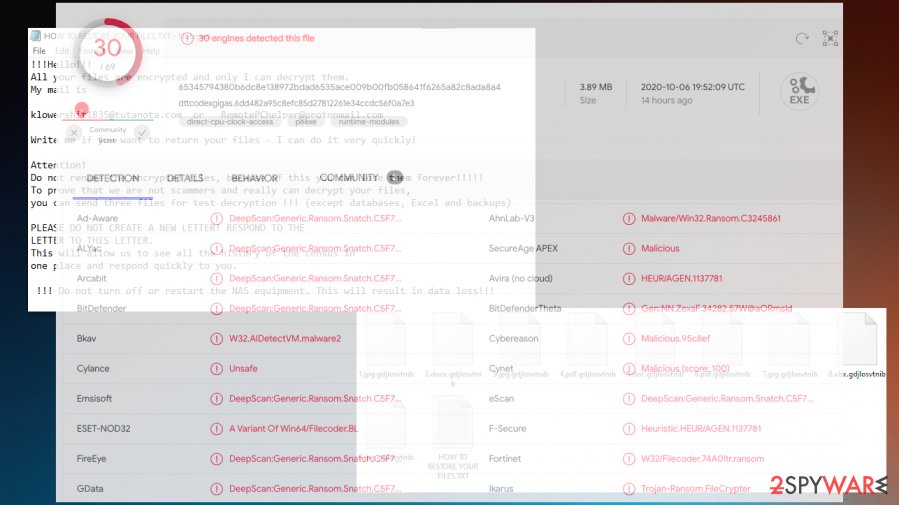
Clhmotjdxp ransomware virus termination relies on anti-malware tool capabilities
Clhmotjdxp ransomware removal success is closely related to the virus's detection rate because the infection can be dropped by the trojan directly on the targeted computer or occur due to a malicious file that was planted or a site or spam email attachment. The ransomware store its files in various parts of the system, so manual techniques are not that easy.
To remove Clhmotjdxp ransomware quicker, get a tool like SpyHunter 5Combo Cleaner o Malwarebytes, so you can run the full system scan on the machine that should indicate all the potential threats, ransomware itself, and associated applications that possibly can create issues with your machine. You should pay attention to the detection list, but remember that this virus might be detected with a different name, based on the database of the AV tool.
You can double-check and should do that, so Clhmotjdxp ransomware virus is fully terminated, and you can move on with file recovery. Before that though, you should clear the virus damage with a tool like FortectIntego that can find, report, and fix file or program issues for you.
Getting rid of Clhmotjdxp virus. Follow these steps
Manual removal using Safe Mode
The machine can be cleared off of Clhmotjdxp ransomware virus if you reboot the system in Safe Mode with Networking
Important! →
Manual removal guide might be too complicated for regular computer users. It requires advanced IT knowledge to be performed correctly (if vital system files are removed or damaged, it might result in full Windows compromise), and it also might take hours to complete. Therefore, we highly advise using the automatic method provided above instead.
Step 1. Access Safe Mode with Networking
Manual malware removal should be best performed in the Safe Mode environment.
Windows 7 / Vista / XP
- Click Start > Shutdown > Restart > OK.
- When your computer becomes active, start pressing F8 button (if that does not work, try F2, F12, Del, etc. – it all depends on your motherboard model) multiple times until you see the Advanced Boot Options window.
- Select Safe Mode with Networking from the list.
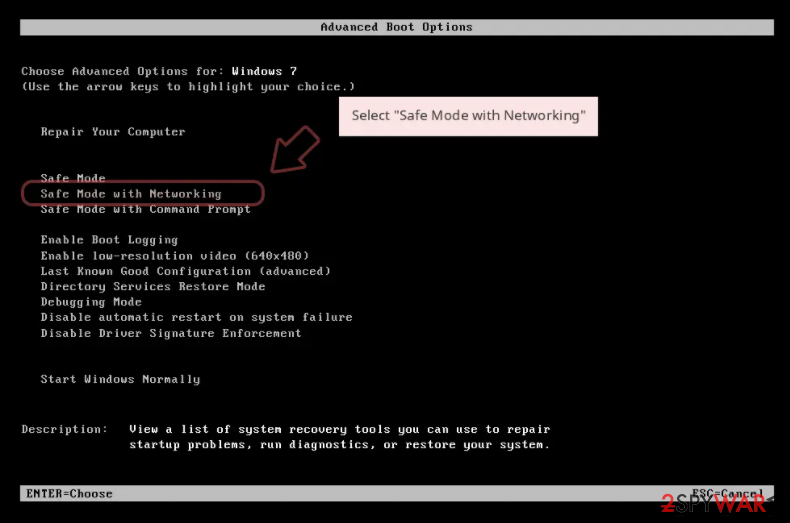
Windows 10 / Windows 8
- Right-click on Start button and select Settings.
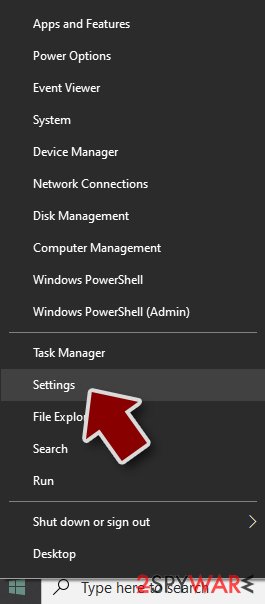
- Scroll down to pick Update & Security.
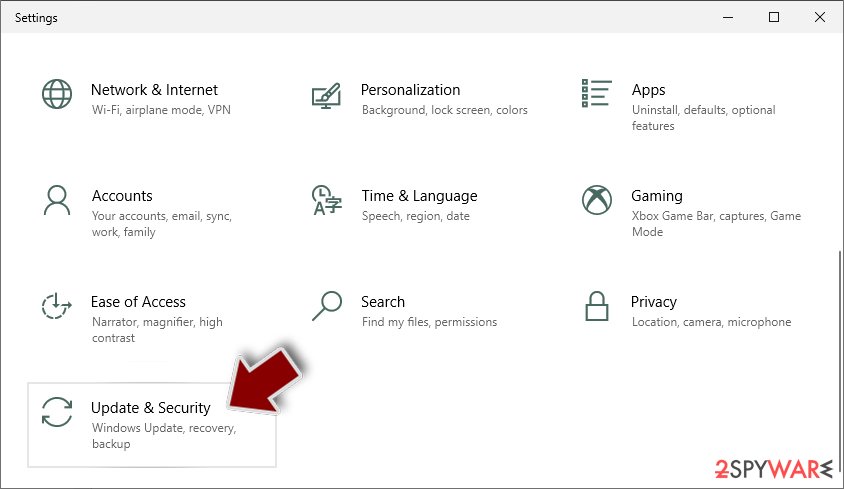
- On the left side of the window, pick Recovery.
- Now scroll down to find Advanced Startup section.
- Click Restart now.
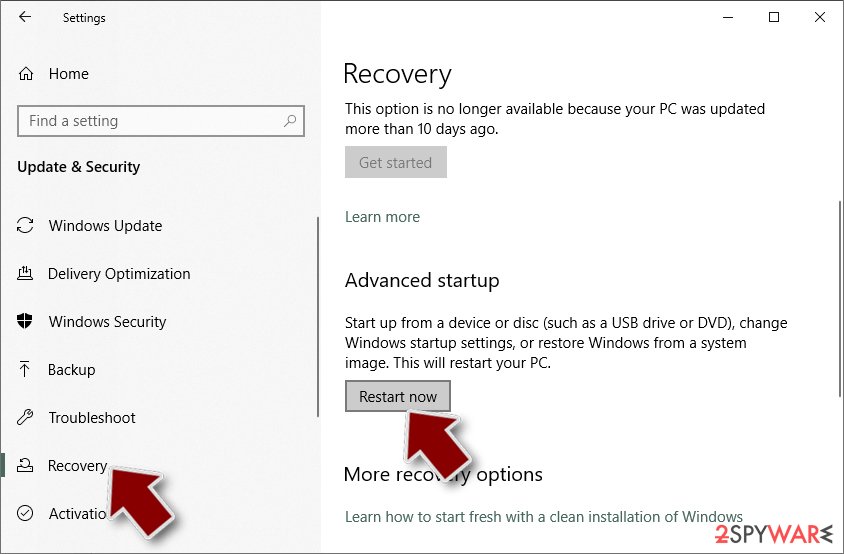
- Select Troubleshoot.
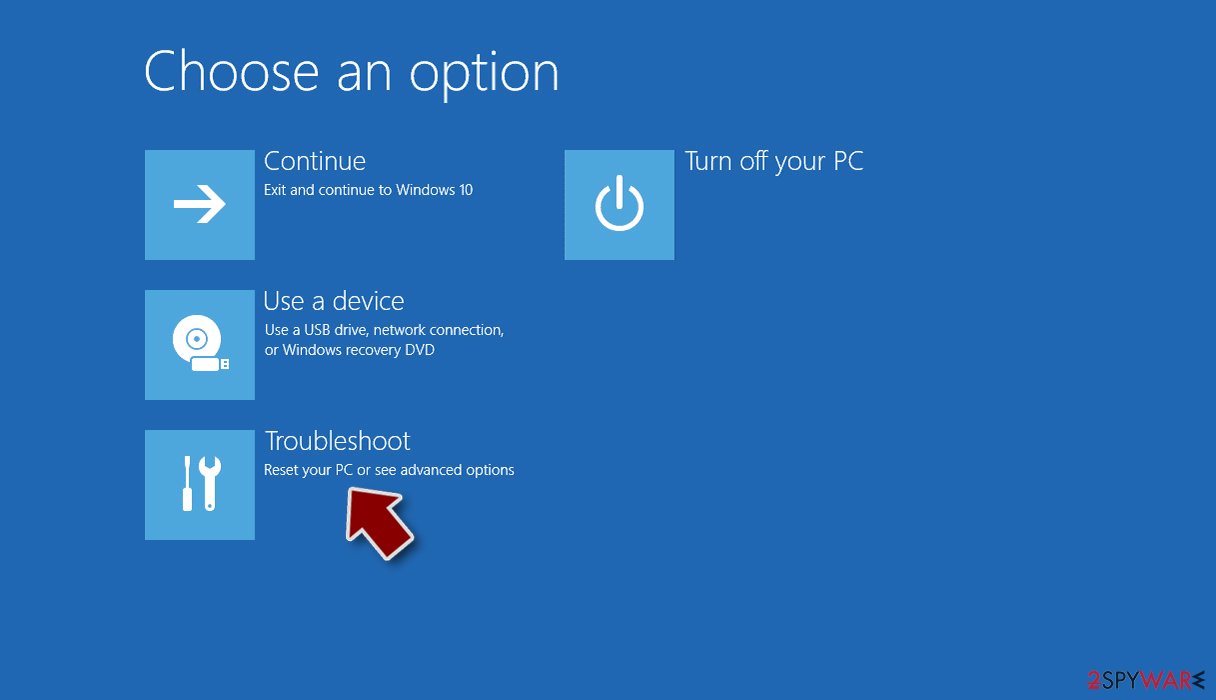
- Go to Advanced options.
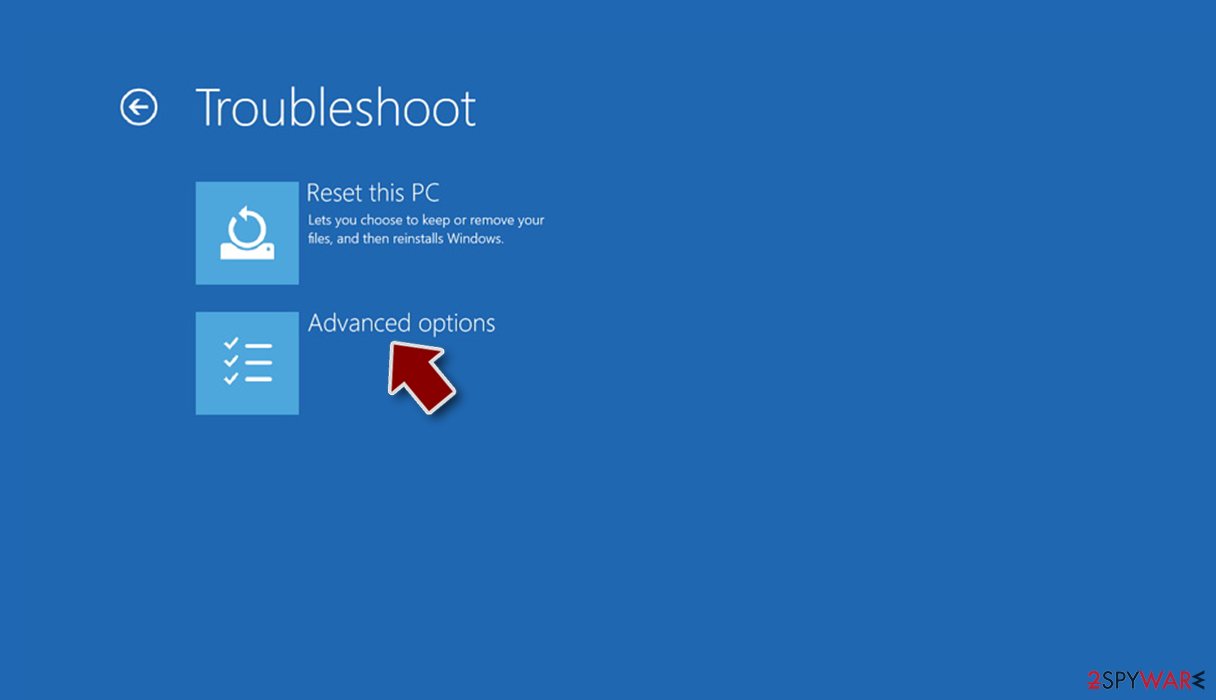
- Select Startup Settings.
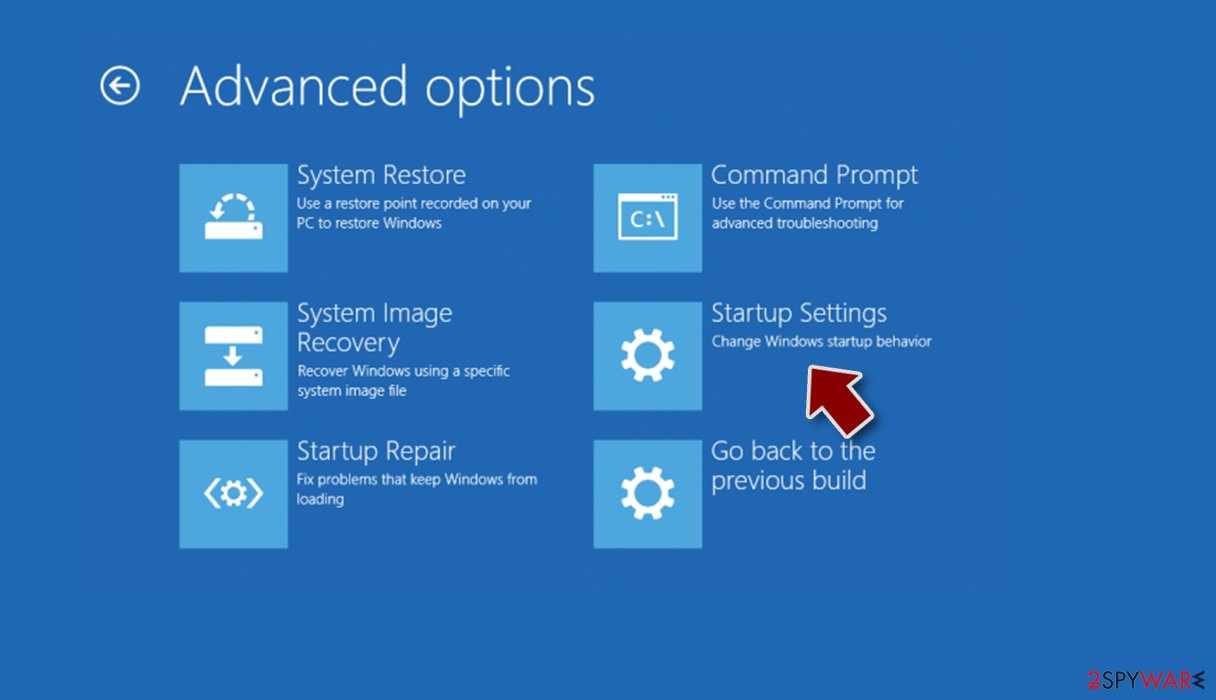
- Press Restart.
- Now press 5 or click 5) Enable Safe Mode with Networking.
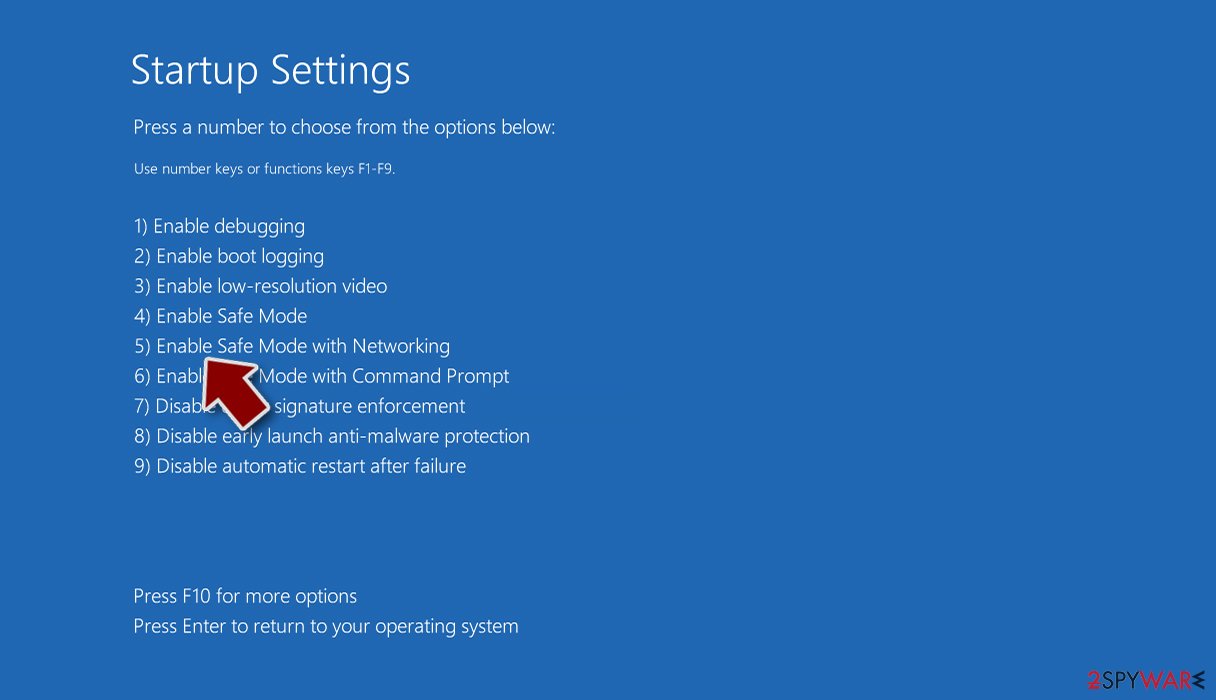
Step 2. Shut down suspicious processes
Windows Task Manager is a useful tool that shows all the processes running in the background. If malware is running a process, you need to shut it down:
- Press Ctrl + Shift + Esc on your keyboard to open Windows Task Manager.
- Click on More details.
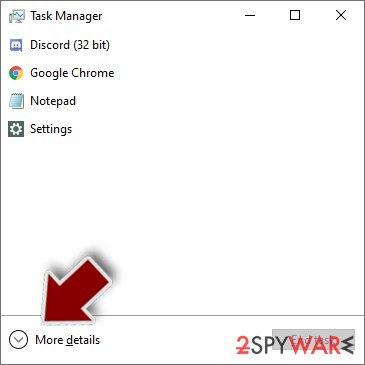
- Scroll down to Background processes section, and look for anything suspicious.
- Right-click and select Open file location.
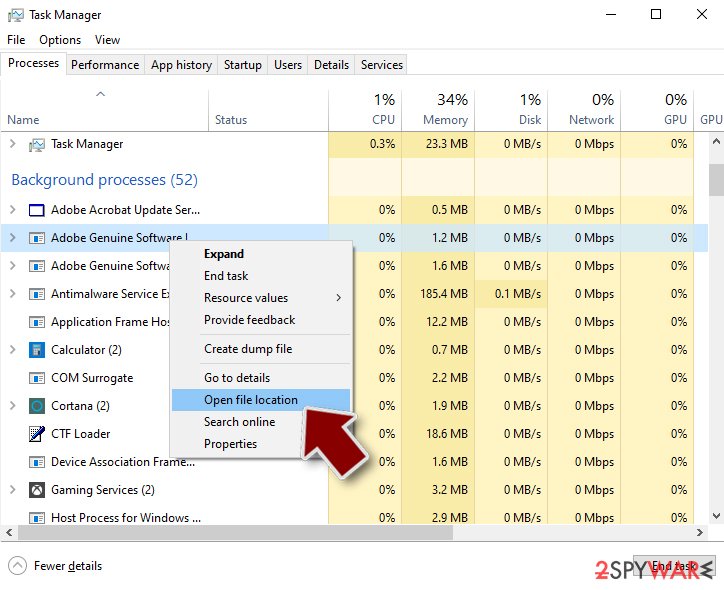
- Go back to the process, right-click and pick End Task.
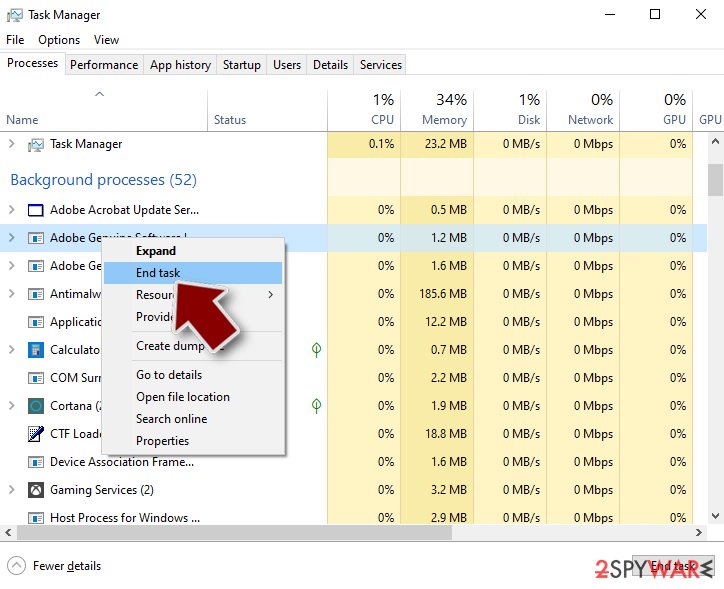
- Delete the contents of the malicious folder.
Step 3. Check program Startup
- Press Ctrl + Shift + Esc on your keyboard to open Windows Task Manager.
- Go to Startup tab.
- Right-click on the suspicious program and pick Disable.
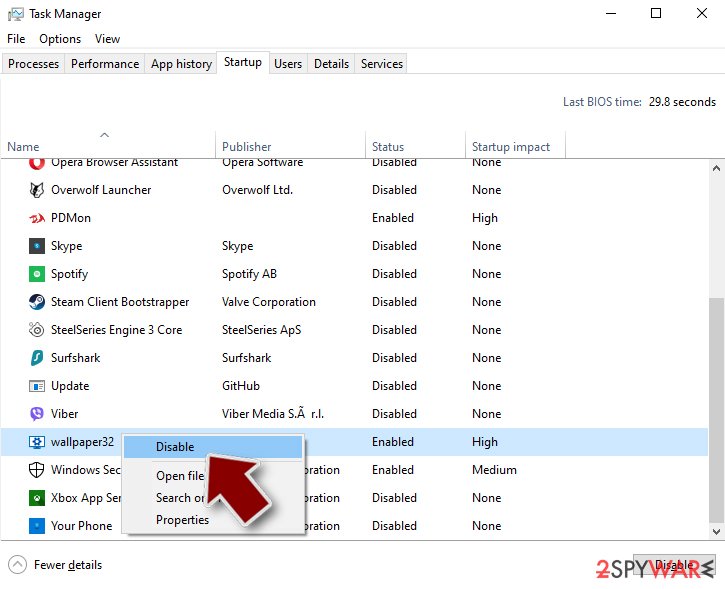
Step 4. Delete virus files
Malware-related files can be found in various places within your computer. Here are instructions that could help you find them:
- Type in Disk Cleanup in Windows search and press Enter.
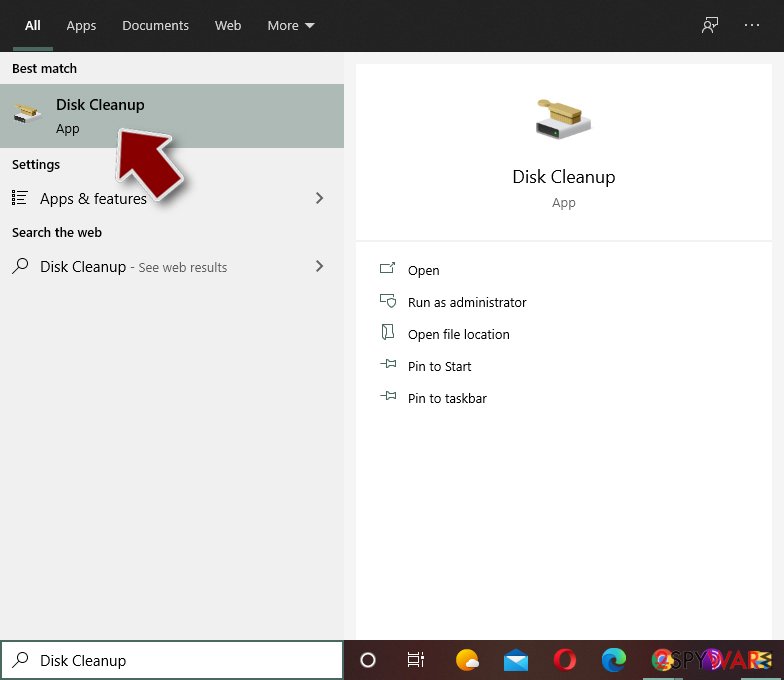
- Select the drive you want to clean (C: is your main drive by default and is likely to be the one that has malicious files in).
- Scroll through the Files to delete list and select the following:
Temporary Internet Files
Downloads
Recycle Bin
Temporary files - Pick Clean up system files.
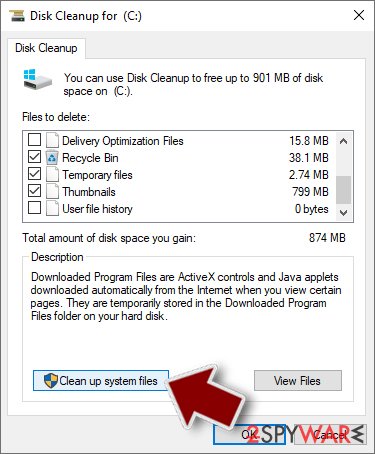
- You can also look for other malicious files hidden in the following folders (type these entries in Windows Search and press Enter):
%AppData%
%LocalAppData%
%ProgramData%
%WinDir%
After you are finished, reboot the PC in normal mode.
Remove Clhmotjdxp using System Restore
System Restore can be the method for your system cleaning because it allows the recovering system in a previous state when the virus was not active
-
Step 1: Reboot your computer to Safe Mode with Command Prompt
Windows 7 / Vista / XP- Click Start → Shutdown → Restart → OK.
- When your computer becomes active, start pressing F8 multiple times until you see the Advanced Boot Options window.
-
Select Command Prompt from the list

Windows 10 / Windows 8- Press the Power button at the Windows login screen. Now press and hold Shift, which is on your keyboard, and click Restart..
- Now select Troubleshoot → Advanced options → Startup Settings and finally press Restart.
-
Once your computer becomes active, select Enable Safe Mode with Command Prompt in Startup Settings window.

-
Step 2: Restore your system files and settings
-
Once the Command Prompt window shows up, enter cd restore and click Enter.

-
Now type rstrui.exe and press Enter again..

-
When a new window shows up, click Next and select your restore point that is prior the infiltration of Clhmotjdxp. After doing that, click Next.


-
Now click Yes to start system restore.

-
Once the Command Prompt window shows up, enter cd restore and click Enter.
Bonus: Recover your data
Guide which is presented above is supposed to help you remove Clhmotjdxp from your computer. To recover your encrypted files, we recommend using a detailed guide prepared by 2-spyware.com security experts.If your files are encrypted by Clhmotjdxp, you can use several methods to restore them:
Data Recovery Pro – possible option for your file recovery
You can try to recover your encrypted files by running Data Recovery Pro
- Download Data Recovery Pro;
- Follow the steps of Data Recovery Setup and install the program on your computer;
- Launch it and scan your computer for files encrypted by Clhmotjdxp ransomware;
- Restore them.
Windows Previous Versions – a method for file restoring
Once you recover the machine using System Restore, you can rely on the Windows Previous Versions feature for individual file restoring
- Find an encrypted file you need to restore and right-click on it;
- Select “Properties” and go to “Previous versions” tab;
- Here, check each of available copies of the file in “Folder versions”. You should select the version you want to recover and click “Restore”.
ShadowExplorer – a method for the Clhmotjdxp ransomware affected files
You can try to repair those files encrypted by the virus when Shadow Volume Copies are left untouched
- Download Shadow Explorer (http://shadowexplorer.com/);
- Follow a Shadow Explorer Setup Wizard and install this application on your computer;
- Launch the program and go through the drop down menu on the top left corner to select the disk of your encrypted data. Check what folders are there;
- Right-click on the folder you want to restore and select “Export”. You can also select where you want it to be stored.
Decryption tool for Clhmotjdxp ransomware virus is not released yet
Finally, you should always think about the protection of crypto-ransomwares. In order to protect your computer from Clhmotjdxp and other ransomwares, use a reputable anti-spyware, such as FortectIntego, SpyHunter 5Combo Cleaner or Malwarebytes
How to prevent from getting ransomware
Do not let government spy on you
The government has many issues in regards to tracking users' data and spying on citizens, so you should take this into consideration and learn more about shady information gathering practices. Avoid any unwanted government tracking or spying by going totally anonymous on the internet.
You can choose a different location when you go online and access any material you want without particular content restrictions. You can easily enjoy internet connection without any risks of being hacked by using Private Internet Access VPN.
Control the information that can be accessed by government any other unwanted party and surf online without being spied on. Even if you are not involved in illegal activities or trust your selection of services, platforms, be suspicious for your own security and take precautionary measures by using the VPN service.
Backup files for the later use, in case of the malware attack
Computer users can suffer from data losses due to cyber infections or their own faulty doings. Ransomware can encrypt and hold files hostage, while unforeseen power cuts might cause a loss of important documents. If you have proper up-to-date backups, you can easily recover after such an incident and get back to work. It is also equally important to update backups on a regular basis so that the newest information remains intact – you can set this process to be performed automatically.
When you have the previous version of every important document or project you can avoid frustration and breakdowns. It comes in handy when malware strikes out of nowhere. Use Data Recovery Pro for the data restoration process.
- ^ Treasury Warns Against Paying Ransomware Demands. Channelnomics. Payment services.
- ^ Ransomware. Wikipedia. The free encyclopedia.
- ^ Virus detection rate. VirusTotal. Online malware scanner.







